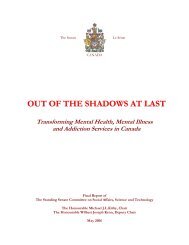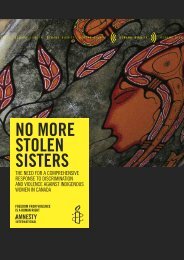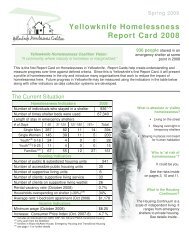THE PINK BOOK, VOLUME III - YWCA Canada
THE PINK BOOK, VOLUME III - YWCA Canada
THE PINK BOOK, VOLUME III - YWCA Canada
Create successful ePaper yourself
Turn your PDF publications into a flip-book with our unique Google optimized e-Paper software.
Reducing Women’s Economic Vulnerability<br />
<strong>Canada</strong> is currently in the midst of a deep recession. Since October 2008, approximately<br />
486,000 full-time jobs have disappeared. 8 Because women earn less and have fewer<br />
benefits than men, they have less of a cushion during hard times.<br />
Women are over-represented in part-time and non-standard work. Women account<br />
for about 7 in 10 of all part-time employees, a figure that has changed little since the<br />
1970s. 9 These women often have difficulty accessing employment insurance (EI) when<br />
they need it. They work extraordinarily long hours to make ends meet, have no benefits,<br />
and have little job security. These risks build during recessions, creating a situation in<br />
which women disproportionately bear the burden of the economic decline.<br />
Another significant group in the labour force are self-employed women. The latest<br />
statistics reveal that more than 1 in 10 employed women in <strong>Canada</strong> are self-employed.<br />
In 2004, almost 840 000 women were self-employed. 10 Women entrepreneurs face<br />
many challenges, including difficulty in accessing capital and benefits. The majority of<br />
women small-business owners earn $30 000 per year or less and have no access to<br />
low-cost health care, no protection for disability, no employment insurance or maternity<br />
benefits, and cannot afford private sector insurance and pension plans. 11<br />
Under Stephen Harper’s Conservative government, and in the midst of the worst<br />
recession in Canadian history, the 2009 Federal Budget failed to deal with these<br />
realities. In fact, the Budget did not contain any initiatives to help women—directly such<br />
as increased early learning and child care spaces, flexible EI rules, or rent supplements<br />
to offset the rising cost of housing. Nor will women receive any substantial benefits<br />
from the $8 billion infrastructure fund. Because the Budget targeted roads, bridges<br />
and other bricks and mortar projects, the jobs created by the infrastructure spending<br />
will mainly be held by men. “No money has been targeted to social infrastructure,<br />
including social assistance, early learning and childcare, health care, home care –<br />
programs which provide essential supports to women and where jobs are frequently<br />
held by women.” 12<br />
A federal Liberal government can do better. The National Liberal Women’s Caucus<br />
is concerned about the impact the recession is having on women. Women’s economic<br />
security is essential for a healthy society.<br />
8<br />
Statistics <strong>Canada</strong>, The Daily, September 4, 2009<br />
9<br />
Statistics <strong>Canada</strong>, March 2006. Women in <strong>Canada</strong>: A Gender-based Statistical Report, 5 th edition, p. 109<br />
10<br />
Statistics <strong>Canada</strong>, March 2006. Women in <strong>Canada</strong>: A Gender-based Statistical Report, 5 th edition, p. 110<br />
11<br />
Report and Recommendations, Prime Minister’s Task Force on Women Entrepreneurs, October 2003, p. 79<br />
12<br />
FAFIA response to the Federal Budget 2009 prepared in collaboration with Kathleen Lahey, Queens University and Lisa Philipps, Osgoode<br />
Hall, March 2009<br />
16<br />
<strong>THE</strong> <strong>PINK</strong> <strong>BOOK</strong>, An Action Plan for Canadian Women

















